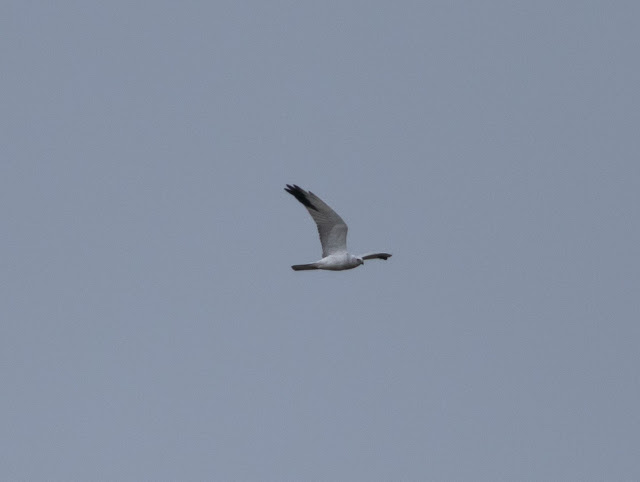Living in England, male Hen Harriers are not a sight I get to see very often. Driving along a stretch of grassy meadows sadly doesn’t yield a floating figure quartering over the fields as it does in Spain and other European countries, and instead numbers have now been depleted to just a few upland breeding sites – if they can cling on amongst the gunfire that besieges them that is. My first ever male Hen Harrier was an individual at Parkgate Marshes many years ago, a ghostly figure hunting distantly on the horizon, no more than a grey spec on the far away skyline. Fast forward several years and I haven’t seen another male Hen Harrier in England since – a very sad sign of the times indeed.
Therefore when a male Pallid Harrier (even more stunning than a male Hen Harrier) was reported as being present at the Forest of Bowland in Lancashire just before the bank holiday weekend - observed displaying and even nest building - it was simply too good of an opportunity to be missed to catch up with this impressive individual. Having seen a juvenile Pallid Harrier down in Somerset a few years ago, this wasn’t a new bird for either myself or Alex, but with only a very small handful of male Pallid Harriers making it over to our shores compared to juveniles, we couldn’t resist going to see this graceful beauty for ourselves.
Therefore when a male Pallid Harrier (even more stunning than a male Hen Harrier) was reported as being present at the Forest of Bowland in Lancashire just before the bank holiday weekend - observed displaying and even nest building - it was simply too good of an opportunity to be missed to catch up with this impressive individual. Having seen a juvenile Pallid Harrier down in Somerset a few years ago, this wasn’t a new bird for either myself or Alex, but with only a very small handful of male Pallid Harriers making it over to our shores compared to juveniles, we couldn’t resist going to see this graceful beauty for ourselves.
Making the gruelling 4km treck
to the best viewing spot along the winding hillside, we were immediately met by a hauntingly pale figure quartering over the moors, swooping down and gliding swiftly along the valley bottom,
white wings shining out as he twisted and turned in the air. Glorious, and the tiring journey up to the
moors was soon forgotten as we watched him perform.
Over the course of the next
two hours the crowd watched on in awe as our ghostly visitor completed several
circuits over the hillside, often sat perched preening on the fence posts for
periods at a time as well as bringing small sticks back to the nest site on several occasions,
spindly twigs held tightly in his bright yellow feet.
With a pattern soon emerging
of crossing over the road to our right and swooping back overhead, eventually
the moment happened that his captive audience had been waiting for, and to
appreciative woops and gasps our male Pallid Harrier begun to skydance. Tumbling through the air with extreme grace and speed, wings twisting in a remarkable
butterfly-esque style while his trilling call echoed out over the valley, he
had the crowd of 30 or so birders completely mesmerised and hooked on his every
move.
Sheer beauty, and to have a
male Pallid Harrier skydancing over your head is a thing of enchanting magic.
Without doubt this was one of the most exquisite birds I’ve seen, and to watch
him perform was an absolute privilege. For anyone thinking of going, but hasn’t
yet got around to it or who may be put off by the long walk – go! You won’t
regret it!
Hopefully the amount of
attention the Pallid Harrier is receiving will save him from the unwelcome
persecution from gamekeepers in the area - indeed, it’s lucky that it was a
birdwatcher that discovered him before the guns did. Sadly though, his aerial
acrobatics will most probably be in vain, as the lack of Hen Harriers (and
raptors in general) during our walk in the Forest of Bowland area was
startling. With the likelihood of a female Pallid Harrier stumbling upon his
airtime show almost nil, it seems the chances of a female Hen Harrier joining
him at the nest (as was the case in Orkney in 1995) are just as depressingly slim.
 |
| Male Emperor Moth!! What an amazing creature! |
For information on where is best to view the Pallid Harrier from, check out the directions page from the RSPB.














No comments:
Post a Comment